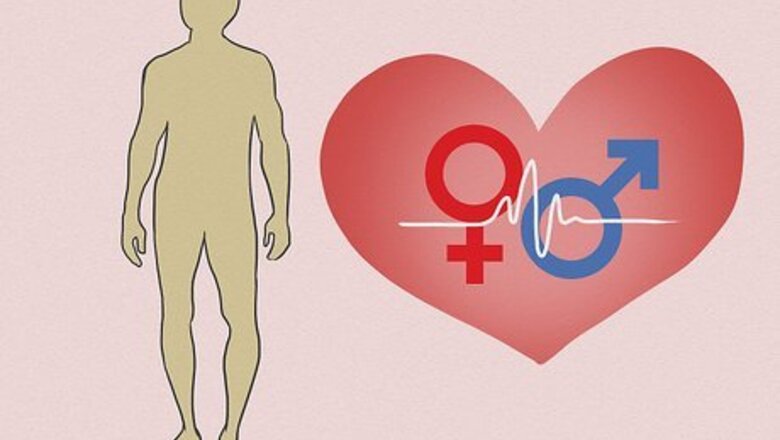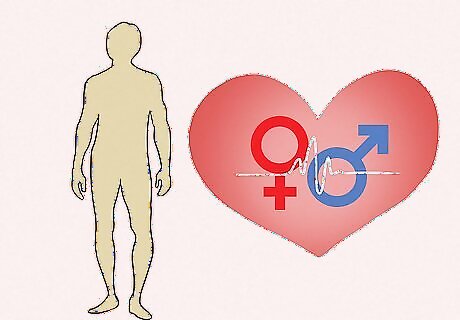
views
- Aceflux people typically fluctuate somewhere along the asexual spectrum. Some may even fluctuate from allosexuality (experiencing sexual attraction) to asexuality.
- The aceflux flag features 5 horizontal stripes that create a pink-purple gradient.
- Abrosexuality refers to someone who has a fluid sexual orientation. This is broader than aceflux, which is a term that’s deeply rooted in asexuality.
What does aceflux mean?

Aceflux is a sexual orientation that fluctuates on the asexual spectrum. Someone who identifies as aceflux automatically identifies as asexual (to some degree), which is a sexual orientation where people feel little or no sexual attraction to others. Asexuality exists on a spectrum—some people may feel completely turned off by sex, while others may feel attraction under certain circumstances. Being aceflux simply means that your sense of attraction shifts around on this spectrum. The word “ace” is shorthand for “asexual.” Aceflux experiences are typically centered on the asexual spectrum, but it ultimately depends on the person. For instance, some aceflux people may feel allosexual (experiencing sexual desire) at times. A person can be aceflux as well as other orientations. For instance, someone could identify as both a lesbian and aceflux (a woman attracted to women whose sense of sexual attraction fluctuates). A biromantic aceflux individual would be someone with fluctuating sexual attraction who is romantically attracted to 2 or more gender identities.
Aceflux Flag

The aceflux flag has 5 horizontal stripes in a red-purple gradient. The first, red-pink stripe stands for allosexuality (experiencing sexual attraction toward others); the second (fuchsia) stripe, the third (magenta) stripe, and the fourth (pink-purple) stripe represent a shift between sexual attraction and a lack thereof; and the bottom (purple) stripe stands for asexuality.
How Aceflux Individuals Can Manage Relationships

Try out different relationship paradigms to find the right fit. Relationships aren’t one-size-fits-all—they come in all shapes and sizes, with certain paradigms working especially well for aceflux individuals: Queerplatonic relationships: Queerplatonic relationships go deeper than a traditional friendship, but don’t quite qualify as romantic. Queerplatonic partners can do a lot of the things that romantic partners do, like moving in together or even getting married. Romantic asexual partnerships: Aceflux individuals might have a lot of success and compatibility dating a fellow member of the asexual community. Polyamorous relationships: Polyamorous relationships involve breaking out of a 2-person relationship and including another (or multiple) partner(s) in the dynamic. If all parties are on board, a poly relationship could be a helpful, consensual way for an allosexual partner to satisfy their sexual desires.

Communicate openly and honestly with your partners. There’s no denying that communication is important in any relationship—but it’s especially important when an ace individual is dating an allosexual. The aceflux partner needs to be okay with discussing sex and being really clear about what they are and aren’t comfortable with, and establish clear boundaries that best represent their needs. That way, their partner will know how to support them. These boundaries ultimately depend on the aceflux individual’s preferences when it comes to sex. They should be upfront with their partner about how their sexual attraction tends to fluctuate, so both parties can be on the same page.
Similar Asexual Terms

Abrosexual Some people define “abrosexual” as a broad term for anyone who has a fluid, fluctuating sexuality. Others use abrosexual as a synonym for aceflux. The term abrosexual can mean different things to different people, especially as the LGBTQ+ lexicon continues to evolve and grow. What matters most is choosing and using labels that feel the most comfortable and accurate to you.

Acespike Acespike people are asexual individuals who feel little/conditional or no sexual attraction most of the time, but who have sudden, deep moments of experiencing sexual attraction. These bouts of attraction don’t last for very long. While the term acespike definitely has some overlap with aceflux, the fluctuation of attraction that most acespike individuals experience is much more drastic and intense than what aceflux individuals experience.

Demisexual Demisexual individuals only feel a sense of sexual attraction after they’ve developed a profound emotional bond with somebody. Does this label strike a chord with you? Try wikiHow’s Am I Demisexual Quiz to take a closer look.

Fraysexual Fraysexual individuals may experience sexual attraction for individuals they don’t know very well, but find that their sexual attraction fades (or “frays”) away as they get to know the person more.

Gray-asexual Gray-asexuals don’t fall into a “black” or “white” part of the asexuality spectrum, but rather a “gray” area. This can mean different things for different people—some feel sexual attraction under certain conditions, or some might feel sexual attraction but don’t wish to engage in the physical act. It ultimately depends on the person!

Reciprosexual Reciprosexual individuals only feel sexual attraction for someone that they know for sure experiences feelings of sexual attraction for them.













Comments
0 comment